Norway and Russia share a boundary in the Barents Sea which divides an entire ecosystem, meaning that two states have mutual responsibility for protecting the environment and safeguarding shared populations of birds, fish and mammals that inhabit this sea area. Cooperation takes place within the Joint Norwegian-Russian Commission on Environmental Protection and the Joint Norwegian-Russian Fisheries Commission.
In the Environmental Commission, the parties meet to discuss current environmental issues and to adopt a three-year programme of work prepared by scientists and administrators from both countries. The programme of work includes projects within the marine environment, natural diversity, pollution, border cooperation, cultural heritage and radioactivity that cover key environmental challenges and help reinforce the knowledge base for the management of the Barents Sea and border areas onshore.
The Joint Norwegian-Russian Commission on Environmental Protection is based on an intergovernmental agreement of 1992. The Commission is headed by the Ministry of Natural Resources and Environment (Minprirody) on the Russian side and the Ministry of Climate and Environment on the Norwegian side.
The Norwegian Polar Institute engages in activities primarily within cooperation on the marine environment and natural diversity, and has a key role in cooperation on the mapping of marine plastic pollution.
Cooperation within the marine environment is concentrated on issues concerning the holistic, ecosystem-based management of the Barents Sea, where significant aspects of the activity are concentrated on strengthening the knowledge base on the environment and resources, as well as human activity and its influence on the sea area.
On the Norwegian side, a comprehensive management plan has been developed for the Barents Sea and Lofoten. The Norwegian plan focuses on balancing planned protection of the environment and resources against predictable frameworks for various types of commercial activity, mainly fisheries, shipping, and petroleum extraction.
One key area of cooperation within the marine environment is to contribute to the development of a comprehensive management plan for the Russian part of the Barents Sea based on experiences garnered from work on the Norwegian management plan. Russia has prepared a roadmap for implementing a management plan for the Russian part of the Barents Sea. This involves the preparation of legislation to strengthen implementation of the plan. This work has taken time, and there is no set date as yet for implementation of a comprehensive management plan in the Russian part of the Sea.
Key marine environment projects in the action plan 2019–2021
Relevant pages
Relevant links
Mapping environmental values and valuable areas
In Norway, significant effort has been devoted to developing a system of environmental evaluation and vulnerability criteria for marine species and their habitats in the country’s territorial waters. The environmental evaluations use scientific criteria to identify ecologically or biologically significant areas in the ocean – the EBSA criteria. The system is based on the criteria that apply to areas of importance for the life-history stages of species and that define areas where marine species assemble for various lengths of time. This concerns primarily areas for spawning, nursery, feeding and wintering. The areas have particular value if they are important for endangered animal species, key species in the ecosystem, or form habitats that are important for biodiversity. The system is presented in two online solutions: Havmiljø (marine environment) and The Marine Spatial Management Tool (the area tool for the Norwegian management plan).
Within the Norwegian-Russian cooperation, there is a collaborative effort to expand mapping of environmental values covering the entire Barents Sea. As part of this, in cooperation with ICES (International Council for the Exploration of the Sea), a report has been prepared that defines common Norwegian-Russian criteria for evaluation, and what constitutes a valuable area – here too based on the EBSA criteria. A framework has also been drawn up for the systematic identification and mapping of environmental values and particularly valuable areas in the Barents Sea.
Work on mapping environmental values will start in 2020 and is expected to be completed by the end of the Environmental Commission’s programme of work 2019-2021. The Norwegian Polar Institute and the Murmansk Marine Biological Institute (MMBI) are heading up the work in close cooperation with the Norwegian Institute of Marine Research and PINRO, Russia’s Polar Research Institute of Marine Fisheries and Oceanography.
Mapping of commercial activities and effects
Norway is in the process of updating or revising the management plan for the Barents Sea – Lofoten. Since 2016, Norwegian experts have been working to revise the knowledge base for comprehensive management of the Barents Sea with a view to completion in 2020. One of seven topics included in the final Action plan for the Barents Sea/Lofoten 2016-2019 incorporated into the review work concerns “Industrial activity, current and future area use and requirements and impact on the environment and other industries”.
Within the commission’s work programme, work has been implemented to develop a joint Norwegian-Russian review of commercial activities and their impact on the environment and other industries. This work will be based on the Norwegian reporting on this topic published in the report Commercial activity and influence: an expert basis for reviewing the management plan for the Barents Sea and the waters off Lofoten.
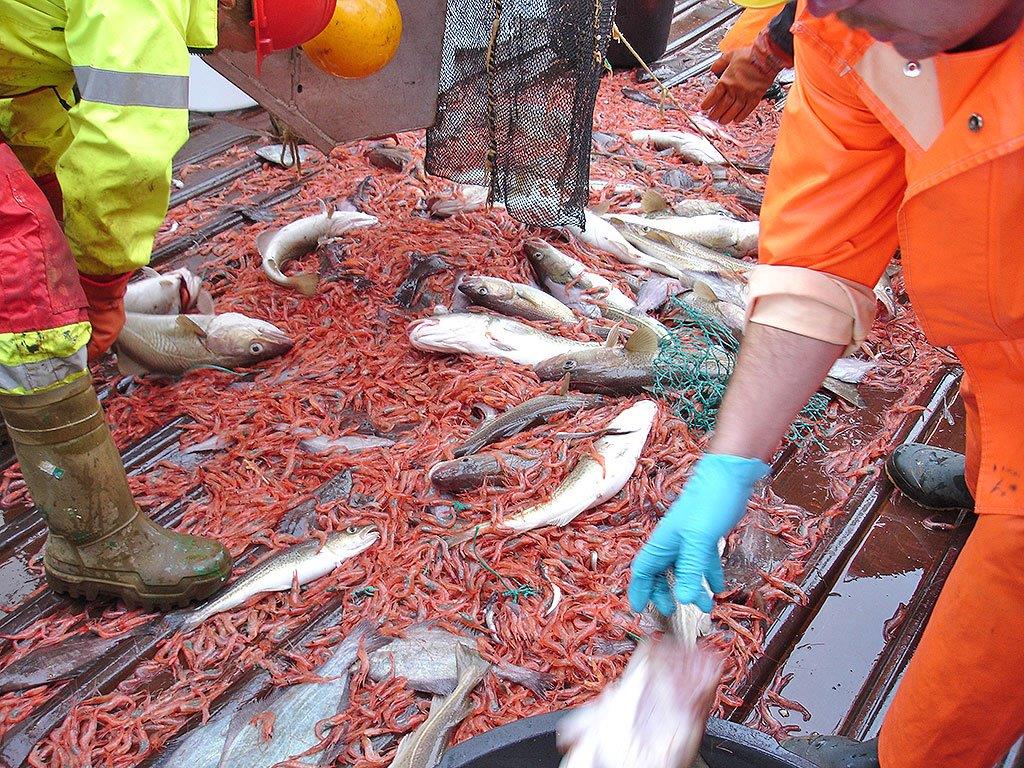
The Barents Sea has rich populations of fish, benthic fauna, zooplankton and phytoplankton. Photo: Cecilie von Quillfeldt / Norwegian Polar Institute
Barentsportal.com – a joint environmental data portal
Joint publication of Norwegian-Russian environmental data through the barentsportal.com web portal strengthens decision support for management and sustainable development in the Barents Sea, and is also a source of information about the environmental conditions in the sea for the general public.
The Norwegian Polar Institute is responsible for coordinating regular updating of the joint environmental status for the Barents Sea in close cooperation with relevant Norwegian and Russian parties. Annual updates of selected ecosystem components are published by the WGIBAR working group of the ICES organisation. Every three years, a full status report is compiled.
Ecosystem-based environmental monitoring
[toc heading_levels=”3″]
Since 2014, Norway and Russia have cooperated on the development of ecosystem-based environmental monitoring for the entire Barents Sea. The objective is to develop coordinated environmental monitoring in Russian and Norwegian parts of the Barents Sea.
This requires a common environmental monitoring framework to be developed. It is expected that the results from the monitoring will be able to contribute as a knowledge base for marine management on both the Norwegian and Russian sides.
A cooperation between Russian and Norwegian experts has developed a joint list of 22 indicators that are considered central to detecting changes in the marine ecosystem. Work is underway to develop a strategy for ecosystem-based monitoring that includes expert discussions of environmental quality goals, thresholds, harmonisation of methodology and reporting systems.
Sebirds
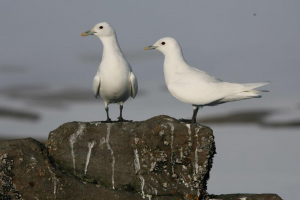
Ivory gulls. Photo: Hallvard Strøm / Norwegian Polar Institute
Norway and Russia share some of the largest seabird populations in the world. The overall goal of the cooperation between Norwegian and Russian expert communities is to create a joint knowledge base for the management of seabirds, to help strengthen joint management of seabird species and to establish coordinated monitoring of populations of seabirds in the Barents Sea. Through this cooperation, a common database has been established for all seabird colonies. Furthermore, joint Norwegian-Russian reports have been published on the status of marine bird species. Joint missions and expeditions to the Arctic islands of Frans Josefs Land, Novaya Zemlya and the mainland coast of Russia have also been carried out in order to update the population status for species of seabirds.
Seabird cooperation between Russia and Norway has been ongoing since 1989. The cooperation has included scientists and administrators from all Norwegian and Russian institutions working on seabird issues in the Barents Sea region.
Seabird database
The Norwegian-Russian seabird database, COLONY, contains key data about all known seabird colonies in the Barents and Kara Seas. The database was established in 1993 and is part of the ongoing work under the Norwegian-Russian network of seabird experts.
The development of COLONY is taking place under the direction of the Norwegian Polar Institute in cooperation with seven Russian institutions. The database is an important tool for solving various management and research tasks in both Norway and Russia, and is a key element in the ongoing work on the establishment of a circumpolar seabird database under the auspices of the Arctic Council/CAFF/CBird – with particular relevance to the CBMP (Circumpolar Biodiversity Monitoring Programme).
Mapping of ivory gulls
Norwegian seabird monitoring includes endangered and vulnerable species where Norway and Russia have joint administrative responsibility. In the cooperation, particular emphasis has been placed on mapping the ivory gull, a high Arctic species, which is classified as vulnerable (VU). The species is mapped, notably, to gain an overview of the breeding population and the effect of changes in ice cover. The focus area is the populations in Svalbard, Franz Josef Land and Severnaya Zemlya. The mapping is conducted by means of aerial counts, use of GPS loggers and digital surveillance cameras in nesting colonies.
Russia has the majority (approx. 80%) of the global population of the species of approximately 14,000 pairs. The Svalbard population of ivory gulls is estimated to be approx. 2000 pairs, and the trend is negative. The largest known colony in Russia is located on Domashniy Island in the Severnaya Zemlya archipelago with 2,000 pairs registered in 2006. However, mapping shows that the breeding stock fluctuates significantly, and, for example, in 2011 was at fewer than 500 pairs.
Seabird distribution outside the breeding season – SEATRACK
New tracking technology using light-level loggers or GLS (Global Location Sensor) has been used to map migratory routes and winter areas for seabirds that nest or winter in the Barents Sea. Through the SEATRACK programme, this gives a new understanding of how this seabird exploits common sea areas in Norway and Russia and beyond the Barents Sea.
The SEATRACK project was formally launched in the spring of 2014. The study area covers 38 locations in the Barents Sea, the Norwegian Sea and the northern North Sea, and includes colonies in Russia, Norway, the UK, the Faroe Islands and Iceland. The study consequently includes not only nesting birds in Norway, but also birds that enter Norwegian waters at different times of the year.
SEATRACK provides knowledge of the area use of Norwegian and Russian seabird populations, including migratory routes and winter areas. There is a great need for knowledge of where the Russian seabird populations in the Barents Sea stay throughout the year. In the Barents Sea, the Russian populations replace the Norwegian ones when the latter migrate southwest in winter. Many of the great autumn, winter and spring populations we have in Norwegian waters, from the Skagerrak to the Barents Sea, are birds from the Russian part of the Barents Sea. These observations are significant for how we assess the consequences of commercial activity in this sea area.
Eleven seabirds have been chosen as focus species. These represent four ecological groups, that is, pelagic diving species, pelagic surface feeding species, coastal surface feeding species and coastal diving species.
Mapping of walrus
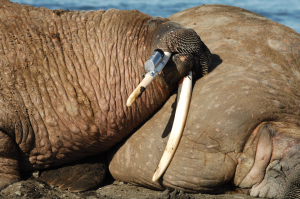
The GPS loggers are attached to the walruses’ tusks and data is downloaded to onshore stations. Photo: Norwegian Polar Institute
In 2010, a Norwegian-Russian programme was established for the study of walrus which includes the species in the Pechora Sea, Franz Josef Land and Svalbard. The results provide completely new insights into which ocean areas the walrus stay in, and how individuals cope with seasonal variation in ice conditions as well as the effects of climate change. For Russian areas, there has been a focus on investigations in the Pechora Sea where knowledge of the species is defined as very weak. The programme includes:
Mapping of distribution and migratory patterns using GPS loggers is based on loggers deployed in both the Svalbard area and the Pechora Sea. These loggers are still collecting data (battery life minimum 5 years) so the results of these surveys are not yet ready. The studies of genetic factors for clarifying population statuses show that the walruses in the Pechora Sea must be considered part of a separate population from the Svalbard – Franz Josef Land population. An aerial count carried out in the Pechora Sea under this programme in 2011 showed that there were only males in the area, indicating that these animals are part of a population with a much larger range – which in that case probably extends far into the Kara Sea. Recent tracking studies conducted by Russian scientists underpin this finding, in that walruses tagged in the Pechora Sea wander far into the Kara Sea. This means that the walruses in the Pechora Sea are part of a much larger population that will also possibly include the walruses in the Kara Sea.
Results from the surveys of environmental pollutants in walrus from Svalbard show a very large individual difference in concentrations of different pollutants. For example, the concentrations of PCB in the blubber range from 27 to 32,000 ng/g lipid, a difference of over 1000x. All samples are from adult males and these extreme differences were also found in previous surveys (from 2002-2004) and it was assumed that this was due to some of the specimens having seals in their diet instead of the normal clams. Analyses of stable isotopes in different tissues from our new walrus material show that this is not the case. All walrus, both those with high and low concentrations of pollutants, feed at the same low trophic level. The only logical explanation for the enormous variations in contaminant concentrations is that some walrus eat in areas where the clams are highly polluted. We currently know nothing more about where these areas may be. Studies conducted by Russian scientists also show a high variation in contaminant concentrations in walrus from the Pechora Sea. Compared with levels from Svalbard, levels of PCB were higher, PBDEs (brominated flame retardants) were similar and oxychlordane (a pesticide) were lower in the Pechora Sea. The studies of the health effects of pollutants found changes in both the hormone and immune systems of walrus that may be linked to high levels of pollutants, but none of the walrus in the study appeared sick.
Mapping of ice-dependent whale species
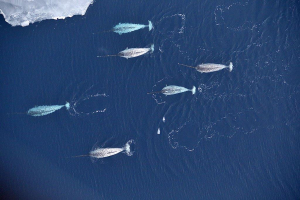
Whale counting in Norwegian parts of the Barents Sea and the Arctic Ocean where whales were recorded and counted, especially focusing on the Arctic ice whales: beluga whales, narwhals (pictured) and bowhead whales. Photo: Magnus Andersen / Norwegian Polar Institute
The dramatic retreat in sea ice occurring in the Barents region represents a major threat to the three ice-dependent whale species belugas, narwhals and bowhead whales. There is deficient knowledge concerning the status of these species, and it is necessary to assess the status and risk they face due to climate change and changes in human activity levels in the High North.
In 2015, a census was carried out of whale species in the marginal ice zones north of Svalbard. The count was performed from the Russian/Norwegian border and westwards (i.e. in Norwegian waters) in cooperation with Russian colleagues.
The count took place from two platforms:
- a zigzag line transect through the marginal ice zone out into open water by ship
- a line transect by helicopter
In an area of just over 52,000 km2 it was estimated that there were 343 bowhead whales and 837 narwhals. None of the observations that formed the data basis for the estimate were made from ship – all were from helicopter. The narwhals stayed deep within the ice, while the bowheads were generally to be found closer to the ice edge.
Based on this census, as well as results from acoustic listening buoys showing that both species were audible year-round in some of the places these were deployed, in 2017 we began an experiment to place biologgers and collect tissue for genetic examination of bowhead whales by helicopter. This project is also supported by the Norwegian-Russian Environmental Commission and field work has been carried out in which Norwegian and Russian scientists cooperate. A total of 25 bowheads were tagged and tissue samples have been collected from 10 individuals for genetic testing. This programme is ongoing and results of some of this material will be published in 2020.
Polar bears
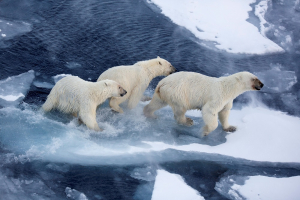
Polar bear counting of the Barents Sea population occurred over fire weeks in the fall of 2015. Polar bear counting occurred in Svalbard and in Norwegian parts of the Barents Sea, where polar bears tell and register. Photo: Norwegian Polar Institute
A polar bear census of the Barents Sea population took place over four weeks in autumn 2015. The polar bear census took place in Svalbard and in Norwegian parts of the Barents Sea, where polar bears are counted and recorded.
Modelling of suitable habitats for polar bear breeding dens in the Barents Sea population has been in progress since 2017. Most of the onshore areas on Franz Josef Land have been mapped (unpublished data), and several traditionally important denning areas of Svalbard have been mapped. These den habitat maps are evaluated using known polar bear den positions based on both observations and den positions determined from satellite telemetry data. These data derive from both the Norwegian side, and Russian colleagues working on Franz Josef Land. Increased cooperation between the Russian and Norwegian side on area use is in planning.
The population size of polar bears in the Barents Sea area was calculated (approximately 2,650 animals) in August 2014, during a joint Norwegian-Russian project. Data on reproduction and condition are collected for animals in the population, for the time being during fieldwork in the Svalbard area. However, with the help of satellite collars, information is available about whether individuals use the areas around Svalbard locally, or belong to the part of the population that migrates between the Norwegian and Russian Arctic.
Genetic studies are in progress, examining the structures of local bears and bears that use the areas on both sides of the border. Discussions with Russian colleagues on genetic samples from Franz Josef Land are ongoing.
Environmental pollutants in polar bears
There is a lack of knowledge about pollutant levels in polar bears that live in both the Norwegian and Russian parts of the Barents Sea.
In 2019–2020, surveys are in progress of mercury, as well as novel and known environmental pollutants, in polar bears from the Barents Sea and the Kara Sea. This continues the surveys of pollutants in polar bears that were initiated in 2017 using funds from the Norwegian-Russian environmental protection cooperation.
In the period 2017-2018, polar bears from the Barents Sea were analysed for a number of pollutants in relation to diet and habitat use. The surveys showed that PFAS (flame retardant) levels in polar bears from eastern parts of the Barents Sea were generally higher than in those from western parts of the Barents Sea. Concentrations of fat-soluble pollutants (PCBs, chlorinated pesticides and brominated flame retardants) were equally high in eastern pelagic and western coastal polar bears. Although the concentration of fat-soluble pollutants in plasma is similar in pelagic and coastal bears, the intake and total amount is higher in pelagic individuals because they are in better condition and have a greater amount of fat in which fat-soluble compounds are stored. Studies also show that the intake of pollutants is higher in pelagic animals due to them eating more at sea and at higher trophic levels, having higher energy needs, eating at the ice edge and having prey closer to sources of pollutants or areas where pollutants are transported. More detailed studies on variations in energy needs are in progress.
The Norwegian Polar Institute and NILU are carrying out a project to analyse pollutants in blood plasma samples from glaucous gulls nesting on Bjørnøya. Glaucous gulls nesting on Bjørnøya accumulate high levels of pollutants, and a link has been documented between these high levels and effects on hormone production, immune systems, breeding success and adult survival. The breeding population on Bjørnøya has shown a decrease since 1986, and a link has been documented between the negative population level and high levels of pollutants in glaucous gulls from this area.
Blood plasma samples have been collected from 1997 to the present day. The samples are taken from glaucous gulls whose demographics (survival and breeding success) are also known. In addition, the birds have had loggers fitted through SEATRACK (from 2009 onwards).
A comparative study of glaucous gull populations in Svalbard (Bjørnøya and Kongsfjorden), Russia (Franz Josef Land) and West Iceland (Melrakkaey) is also in preparation.
Videos about Norwegian-Russian cooperation
For subtitles choose full screen and push “c” on the keyboard.
